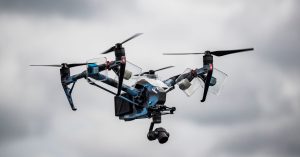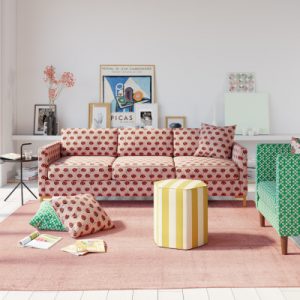Adam Savage is swinging a sword at my face. We’re standing on opposite sides of a bench in the television host’s workshop in San Francisco’s Mission district. A giant model of a hammerhead shark dangles from the ceiling above us, strung up next to a replica of the creepy severed-head spider monster from John Carpenter’s The Thing. Every inch of the surrounding workshop (or, as Savage calls it, his cave) is a veritable I Spy of cool stuff: spacesuits, giant posters, dozens of faithfully re-created movie props, racks and racks of tools, and, of course, swords.
The blade Savage currently wields is a scale replica of Boromir’s sword from The Fellowship of the Ring. He’s brought it to the bench today to build a scabbard for it using wood, sheepskin, and leather. The whole process will take about eight hours. As he talks, Savage’s benevolent mad scientist persona is on full display. He gesticulates with his hands, one of which is still gripping the sharp, pointy sword. Suddenly, he whips the weapon straight at me. I flinch, but it’s too late. The sword plunges directly into my forehead. Or at least it would have, if I were physically inside the workshop.
Thanks to the futuristic magic of virtual reality, I am happily un-decapitated. In real life, I’m in the comfort of my office, wearing an Oculus Quest headset and trying out a demo of a new app, called Adam Savage’s Tested VR, which launches tonight. It’s a partnership between Oculus and Adam Savage’s Tested, an online platform for showcasing the work of Savage and other creative makers and their workshops. The app is an extension of that, meant to give the viewer the feeling of being right there at the bench while an artist builds their creation.
“The videos we produce are very different than those for television broadcasts,” Savage says. “When we put it in VR, we found such an intimacy to watching someone work.”
The modules in the app aren’t typical gamey-VR environments. The starting room is the only part that has full interactivity. It’s modeled as a cardboard facsimile of Savage’s full workshop, with an array of items on a table that the user can interact with. (I spent a lot of time there, flailing around with my digital robot hands, trying to knock as much stuff to the ground as possible.) But the bulk of the experience is made up of separate episodes. An episode displays as a live-action video, albeit one that immerses you. I can look around, and up and down. The depth gives the impression that I am right there, standing next to someone as they work. Aside from twisting my head, I don’t move around. The camera does that on its own, smoothly changing positions to give the viewer different angles or closer looks at the intricacies of the construction process. When I turn, the headset tracks the sound, so I still hear it coming from where its source should be.
Each episode is around 15 minutes long and features the work of a different creator. There’s one with Griffon Ramsey, an Austin, Texas–based artist who uses chainsaws to shear elaborate sculptures out of wood and ice. (She carves a wooden dodo in her video.) Another features puppeteer Rick Lyon, who previously worked on Sesame Street and designed all the puppets for the Broadway musical Avenue Q. In each video, the maker guides the viewer through their creative process.
Lyon sees the app as exemplary of the “golden age of the maker” we’re experiencing right now. “It’s lovely to have these videos to get a little peek into the variety of stuff that people are creating and the artwork these people are generating,” he says.
The sense of presence that one gets from VR is what makes things interesting here. When Ramsey takes a chainsaw to a gigantic log, the sawdust and curly wood scraps spray around me as they fall to the ground. When Savage goes to weld something in his video, I actually hop backwards as bright blue sparks zap out at me. The fluidity of VR keeps it from having the gimmicky feel of a 3D movie. It’s not just that sparks are flying toward my eyes. It’s that I feel like I’m actually there. The way to keep from being disoriented by the whole thing is to accept it as if it’s reality. For a split second, my subconscious thinks I’ve been stabbed in the brain.
“It’s almost like being able to lean into the screen,” says Ramsey, the chainsaw artist. “In the past there was almost like this invisible wall up, but now it’s like you can break through this wall and feel like you’re there witnessing it.”
Virtual reality and alternate reality technology has real potential to change how we learn. Being brought so closely into an expert’s development process, even if that closeness is an illusion, engages the viewer in a multisensory way that goes beyond the connection you’d get watching something on a standard screen.
“For me as a maker, when I see someone doing something in front of me, it’s twice as easy to understand as if they’re doing it on a screen,” Savage says. “And that’s just the nature of the way I think our brains process information.”
At launch, the app will have eight episodes, including the session with Savage and his sword. It’s free to download, but for now, is available only for the Oculus Go and the Oculus Quest. A producer at Tested told me that they hope to expand to other platforms in the future, so long as that hardware can support the high resolution videos. They also plan to add more episodes with more creators.
“This is a new format,” Savage says. “It’s a new narrative storytelling device, and it requires entirely new ways of thinking. And I’m getting really excited about the idea of people more and more people producing VR video.”
More Great WIRED Stories
- xkcd’s Randall Munroe on how to mail a package (from space)
- Why “zero day” Android hacking now costs more than iOS attacks
- Free coding school! (But you’ll pay for it later)
- This DIY implant lets you stream movies from inside your leg
- I replaced my oven with a waffle maker, and you should too
- 👁 How do machines learn? Plus, read the latest news on artificial intelligence
- 🏃🏽♀️ Want the best tools to get healthy? Check out our Gear team’s picks for the best fitness trackers, running gear (including shoes and socks), and best headphones.



